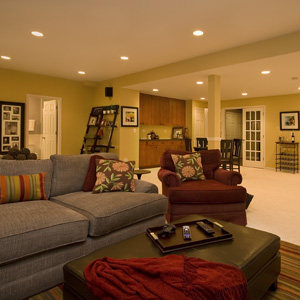Generally, a lighter color palette on the walls is a good idea to keep the basement from looking dungeon-like. Photo:Courtesy of BasementIdeas.com/Deanna Burkhart, Vanide
Tiptop Shape
If you’re trying to create your dream space in your basement, you’ll want to finish your ceiling with drywall. A drop ceiling will always make the space feel like a basement, says Dave Schrock, author of Basement Ideas.
-
Decorating Down Under
What to consider when planning your basement transformation.
- by Des Keller
In many homes, the most cost-effective way to gain livable space is to finish or renovate the basement. After all, the square footage is already there. If you have a basement renovation in mind first decide what type of role you want the basement to play: Will it be a family game room, a playroom, a media lounge, a guest bedroom, a home office, or a combination? Once you have a vision in place, follow these steps:
Get Planning
Use graph paper, a home design software program, or HomeFurnishings.com’s Room Planner, to map out your ideas. “If you spend the time to do the planning upfront, you’ll really get a good idea of what the area will look like and whether you can get everything you want into it,” says Dave Schrock, author of Basement Ideas, whose firm specializes in lower-level renovations.
Evaluate Your Space
Take a close look at the walls and floor of your basement. What kind of shape are they in? Moisture or neglect may have damaged them over the years but there are plenty of repair/renew options.
- Look Up: A ceiling where heating and air conditioning ducts and wiring are visible won’t have a very finished look, no matter what you do to the rest of the room. The two basic options are to install a drop ceiling (which allows you to retain access to utilities and lighting) or use drywall. Schrock prefers drywall: “It will always feel like a basement if you do a drop ceiling,” he says.
- Light and Dark: In terms of natural light, basements range from no light at all to light-filled rooms with walkout French doors. Generally, a lighter color palette on the walls is a good idea to keep the basement from looking dungeon-like. “I would say a splash of color is great,” says Schrock. “I like to see some kind of accent wall of red or some complementary color.”
- Underfoot: These days even a concrete floor can be chic—and can be stained or painted and combined with area rugs for warmth. Concrete can also be stamped to look like tile or stone. Other flooring options such as wood, laminate, carpet and vinyl should be evaluated based on their unique features and your purpose for the room.
- Turned On: To make a basement room feel larger and lighter, Sheri Toth, owner of Artistic Spaces in Columbus, Ohio, suggests using stylish track lights to highlight light-colored walls. She uses ambient lights such as torchiere floor lamps and recessed can lights—because hanging overhead fixtures tend to shrink the height of ceilings that are often already low.
Choose Wisely
Homeowners should give a lot of thought to the functionality their new space will serve. Joan Scheib of Chicago-based Joan Scheib Interiors gives clients a questionnaire to complete about the activities they like, the kinds of materials and fabrics they prefer, and the types of accessories they want to incorporate into their “new” basement.
- Wood You? There really are no restrictions on what furniture materials should or shouldn’t be used in a basement, according to Scheib. Most all woods and other materials will hold up fine in a slightly more humid environment—and portable de-humidifiers can be used when necessary. Scheib does caution against using wood flooring in basements that are well below ground level because of the chance of warping over time.
- How Big? Homeowners tend to underestimate how big furniture will appear in their renovated basement, says Scheib. “Mostly people pick furniture that is too large in relation to the size and shape of the room and other furniture items,” she says. “Scale is important.” The result is over-crowding and poor traffic flow.
A Word about Water
Historically, basements have issues with water seepage and leakage. The problem is most often dealt with by the use of sealants or sealant paints on basement walls, whether they are drywall or cinderblock. Schrock recommends letting walls “breathe” and using gravity-flow drains or sump pumps installed at the base of interior or exterior walls.


